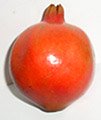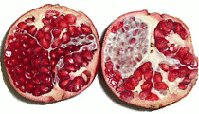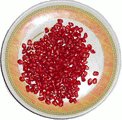Pomegranate Nutrition facts
Pomegranate is one of the most popular, nutritionally rich fruits known for its unique flavor, taste, and health-promoting characteristics. Together with sub-arctic pigmented berries and some tropical exotics such as mango, it too has unique qualities of functional foods, often called “super fruits.”
Botanically, it is a small-size fruit-bearing deciduous tree belonging to the Lythraceae family, of genus: Punica.
Scientific name: Punica granatum.
 |
 |
| Pomegranate fruit-Punica granatum. | Cut section of the fruit with thin whitish membrane enveloping aril sacks. |
Pomegranate tree is thought to have originated in the Persia and Sub-Himalayan foothills of Northern India. It grows about 5 to 8 meters tall. It is cultivated at a commercial scale in vast regions across the Indian sub-continent, Iran, Caucuses, and Mediterranean regions for its fruits.
A completely established tree bears several spherical, bright red to orange-yellow colored fruits depending on the cultivar types. On average, each fruit measures about 6-10 cm in diameter and weighs about 200 gm. Its outer skin (rind) is thick and features a leathery texture.
Interior structure of the fruit is separated by white, thin, spongy, membranous, bitter tissue into discrete compartments. Such sections, packed as sacs, filled with tiny edible sweet, juicy, pink arils encasing around a single, angular, soft, or hard (in the case of overmature fruits) seed.
8 Unique Health benefits of Pomegranate
Pomegranate carries about 83 calories per 100 grams; slightly more than that of in the apples. It contains no cholesterol or saturated fats.
It is a good source of soluble and insoluble dietary fibers; providing about 4 grams per 100 g (about 12% of RDA). Dietary fiber aids in smooth digestion and bowel movements.
Nutritionists often recommend pomegranate in the diet to reduce weight and control cholesterol. Regular inclusion of fruits in the diet boosts immunity, improves circulation, and offers protection from cancers.
Certain ellagitannin compounds such as Granatin B, and Punicalagin are found abundantly in the pomegranate juice. Studies suggest that punicalagin and tannins can be effective in reducing heart disease risk factors by scavenging harmful free radicals from the human body.
Total antioxidant strength of pomegranate fruit measured regarding its oxygen radical absorbance capacity (ORAC) is 2341 µmol TE/100 g.
The fruit is also a good source of antioxidant vitamin-C, providing about 17% per 100 g of the daily requirement. Consumption of fruits rich in vitamin C helps the body develop the ability to combat infectious agents by boosting immunity.
Regular consumption of pomegranate has also been found to be effective against prostate cancer, benign prostatic hyperplasia (BPH), diabetes, and lymphoma.
Further, it is also a good source of many vital B-complex groups of vitamins such as pantothenic acid (vitamin B-5), folates, pyridoxine, and vitamin-K, and minerals like calcium, copper, potassium, and manganese.
| Principle | Nutrient Value | Percent of RDA |
|---|---|---|
| Energy | 83 Kcal | 4% |
| Carbohydrates | 18.70 g | 14% |
| Protein | 1.67 g | 3% |
| Total Fat | 1.17 g | 6% |
| Cholesterol | 0 mg | 0% |
| Dietary Fiber | 4 g | 11% |
| Vitamins | ||
| Folates | 38 µg | 9.5% |
| Niacin | 0.293 mg | 2% |
| Pantothenic acid | 0.135 mg | 3% |
| Pyridoxine | 0.075 mg | 6% |
| Riboflavin | 0.053 mg | 4% |
| Thiamin | 0.067 mg | 5.5% |
| Vitamin A | 0 IU | 0% |
| Vitamin C | 10.2 mg | 17% |
| Vitamin E | 0.60 mg | 4% |
| Vitamin K | 16.4 µg | 14% |
| Electrolytes | ||
| Sodium | 3 mg | 0% |
| Potassium | 236 mg | 5% |
| Minerals | ||
| Calcium | 10 mg | 1% |
| Copper | 0.158 mg | 18% |
| Iron | 0.30 mg | 4% |
| Magnesium | 12 mg | 3% |
| Manganese | 0.119 mg | 5% |
| Phosphorus | 36 mg | 5% |
| Selenium | 0.5 µg | 1% |
| Zinc | 0.35 mg | 3% |
| Phyto-nutrients | ||
| Carotene-α | 0 µg | -- |
| Crypto-xanthin-β | 0 µg | -- |
Selection and Storage
World’s best pomegranates grown in the southern parts of Afghanistan in Kandahar, Balkh, Helmand, and Nimruz provinces.
A pomegranate fruit is judged ripe when it develops a distinctive color and imparts a metallic sound when tapped by the fingertip. It must be picked up at the right time before turning overmature; otherwise, its seeds become harder and inedible, and the whole fruit tends to burst open and spoil.
In the markets, choose well-developed, firm, bright crimson red fruits. Avoid spotted, over-mature fruits as they can be bitter and inedible. Furthermore, avoid those with surface cracks, mold, bruised, or shriveled as they are inferior in flavor.
At home, store them in a cool dark place at room temperature for 5-8 days or more. In general, pomegranates possess a long shelf life. You can also put them in the refrigerator for a couple of weeks.
Preparation and serving method
Wash pomegranate fruit in cold water or rinse in tepid water to bring it to normal temperature if kept inside the cold storage.
 |
Pomegranate is one of the popular fruits employed in the food industry. Its value as food, flavor, and color, makes it a common item in the category of new functional foods, often called “super fruits." To experience its rich flavor, eat fresh fruit as it is without seasoning/additions.
To prepare, clean the fruit using a paper towel or soft cloth. Using a paring knife, score superficially into two halves on its tough outer rind, and then break it by pulling it apart. Gently lift clusters of aril sacs, and remove white- membrane, pith, and rinds.
Alternatively, hold the section of fruit upside down and beat gently with a wooden stick so that its seeds drop down detached. Separating its juicy, delicate arils is simplified by performing this task in a bowl of cold water, whereby its seeds settle down at the bottom and pulp and pith float. Remove water and gently pat dry seeds using a soft cloth.
Pomogranate seeds make an attractive garnish on salads and dishes.
Fresh fruits make fantastic refreshing juice.
Pomegranate juice can be employed to prepare soups, jellies, sorbets, and sauces as well as to flavor cakes, baked apples, and other desserts.
It is used in the preparation of traditional Persian recipes such as fesenjan, made from pomegranate juice and ground walnuts rice pilaf, and delicious ash-e-anar soup.
Pomegranate concentrate is a popular ingredient used in Middle Eastern and Mediterranean recipes. The juice is concentrated to about 250% stronger into a thick sauce (grenadine). When added to cooking, it gives a unique flavor and intense sweet taste. Grenadine is added to make non-alcoholic drinks, sorbets, and in several mouth-watering Middle-Eastern dishes.
≺≺-Back to Fruits from Pomegranate. Visit here for an impressive list of all varieties of fruits with complete illustrations of their nutrition facts and health benefits.
≺≺-Back to Home page.
Further reading and Resources:
Stanford School of Medicine Cancer information Page- Nutrition to Reduce Cancer Risk.
Carbonic anhydrase inhibitors from the pericarps of Punica granatum L; Satomi, H.; Umemura, K.; Ueno, A.; Hatano, T.; Okuda, T.; Noro, T. (1993). Biological Pharmaceutical Bulletin 16 (8): 787–790.